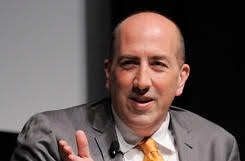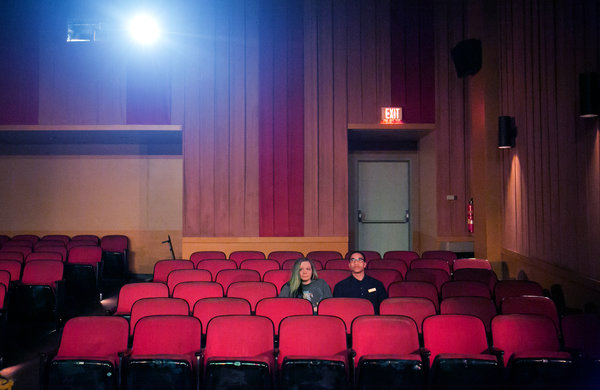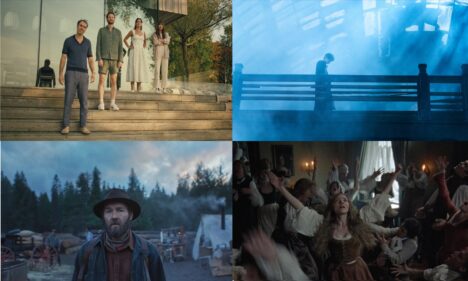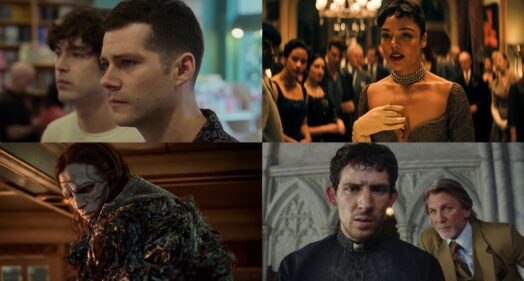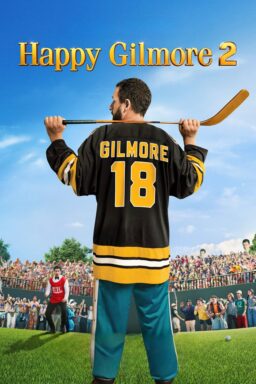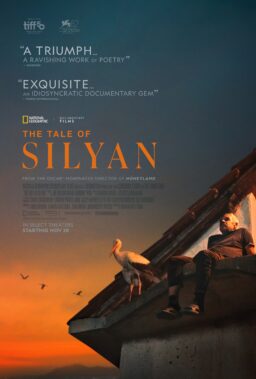Attention movie people who don’t think they’re theater
people (especially if they’re movie people in New York City): there’s a play
you really ought to see anyway. Annie Baker’s “The Flick,” currently at the
intimate Barrow Street Theater in New York’s Greenwich Village, is a
Pulitzer-Prize-winner with a theme that seems, on the surface, rather unlike the sort
of grand stuff that wins Pulitzer Prizes.
Over the course of two acts in a little over three hours,
“The Flick” lets the audience get to know three young (or, in one case,
youngish) people working in the eponymous movie theater in Massachusetts in the
summer of 2012. Veteran Sam (Matthew Maher), a voluble, bald-pated guy in his
thirties, shows the ropes to Avery (Aaron Clifton Moten), a very soft-spoken
and awkward African-American who seems barely out of his teens. The action
moves very slowly; the two fellows sweep the floor, reflect on the sometimes
disgusting things people leave there, and begin talking movies. Soon into their
relationship, Sam starts playing the “six degrees” game with Avery, and is
staggered by his movie knowledge. Avery’s movie knowledge extends way past
movies Sam doesn’t even know; at one point, while sweeping, Avery whistles the
song “Le Tourbillon” from Truffaut’s “Jules and Jim,” and Sam clearly couldn’t
be less interested in Georges Delerue’s tune. (The play’s exit music is from
“The 400 Blows” if I’m not mistaken.) Eventually, we find out that Avery is at
the very least depressive; one scene shows him in the darkened theater, on the
phone, leaving a message for his therapist. He’s also a man on a kind of
mission; he confides to Sam that he wanted to work at The Flick because it’s
one of the last theaters in the area with a 35mm projector, and he’s VERY
anti-digital. He gets the theater’s projectionist, the feisty, bluff
Rose (Louisa Krause), to teach him how to work the machine. Much to Sam’s
resentment. The two fellows end up having equally fraught exchanges with the
theater’s sole female employee.
The play’s excited some controversy because of its slow pace.
In the first act, there are long stretches in which the characters just do
their jobs. And then, when they deign to speak to each other, they seem to be
speaking about nothing, or about inside-baseball (for some) stuff such as movie
references and film-versus-digital. But there’s a very good reason the play got
the award it did. It rewards close attention. In fact, it demands close
attention. The grand trick it performs is to make an amazing human drama out of
a very hermetic corner of human exchange and endeavor, and it needs the time it
takes, the stretches of breathing, to bring that drama home. The modesty is the
message: this is the first play I’ve been to in some time at which the actors
(all of them superb) haven’t been somehow artificially amplified.
And also, as it happens, despite its veneer of
naturalism, the play’s writing operates, eventually, at near Stoppard-like
levels of cleverness. The stuff the three friends/antagonists talk about in the
first act, the allusions and “aesthetic” concerns they mull over, are, besides
things in and of themselves, thematic land mines laid down to be tread over in
the second act. Every one of them pays off in a way that’s not just theatrically surprising, but emotionally resonant. A way that reflects
on why both film and theater remain such potentially powerful art forms. And
you don’t have to get all the film references in order for their deeper
significance to pay off. But if you do, all the better.
